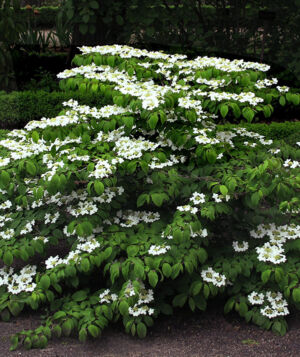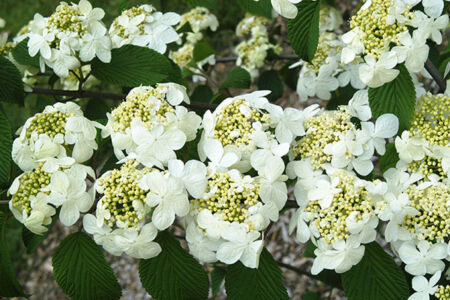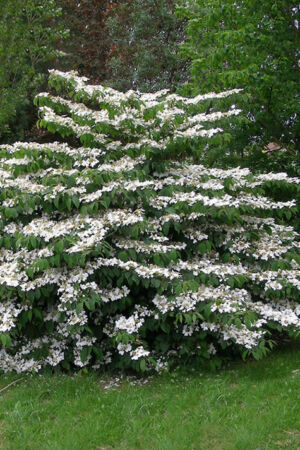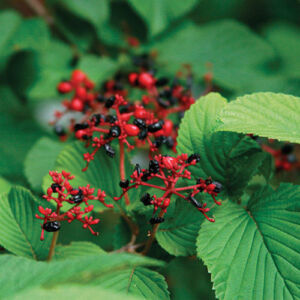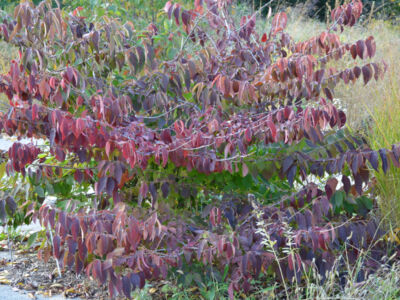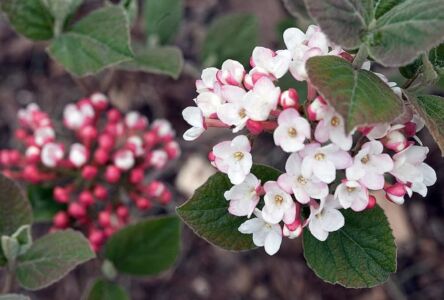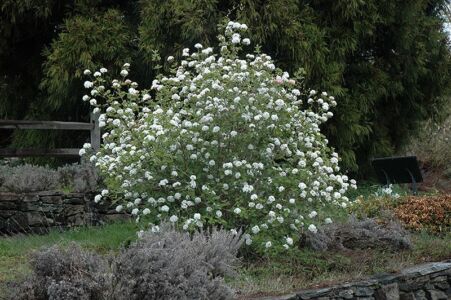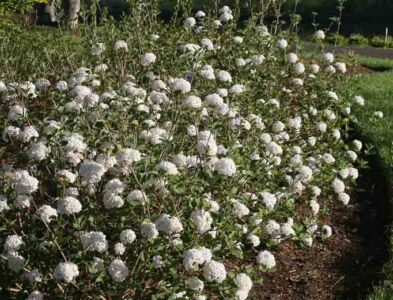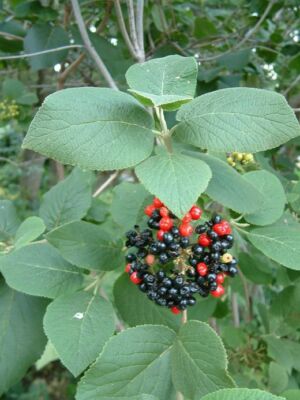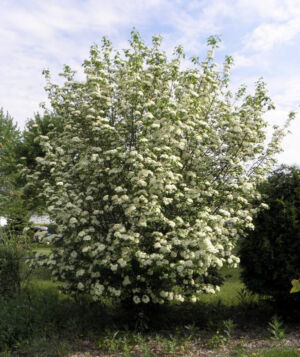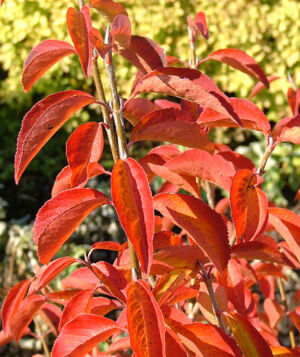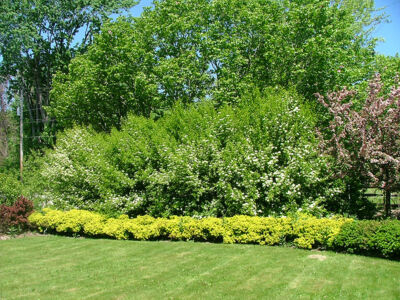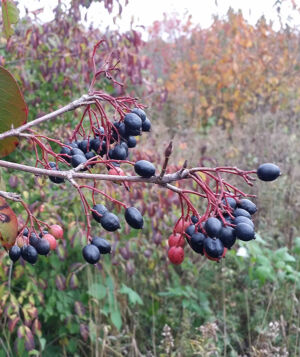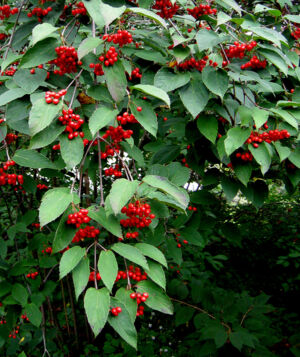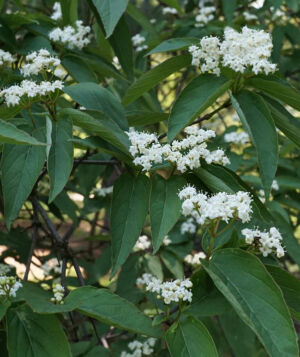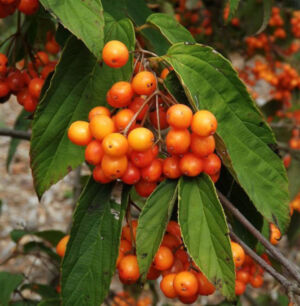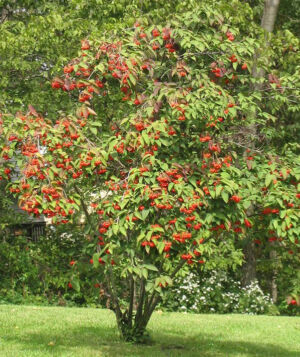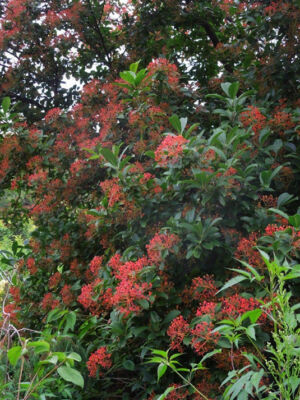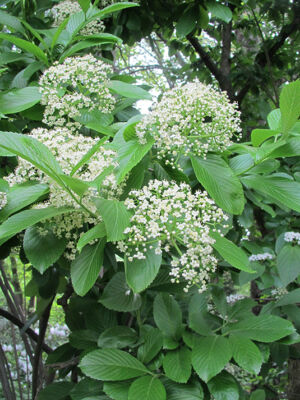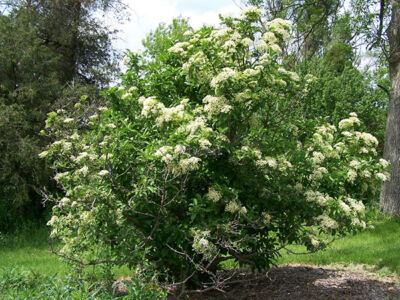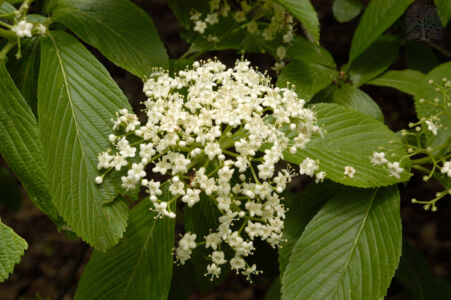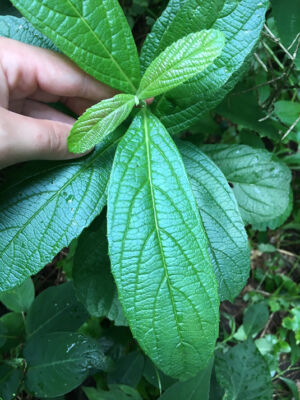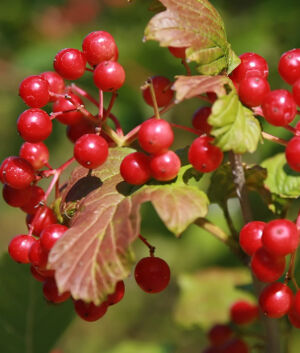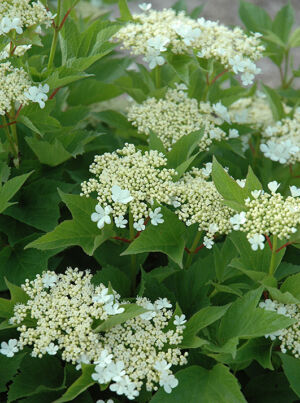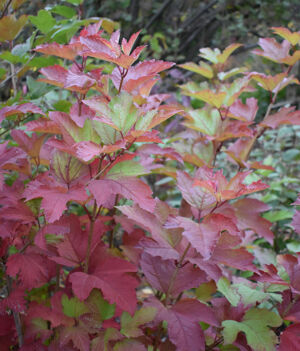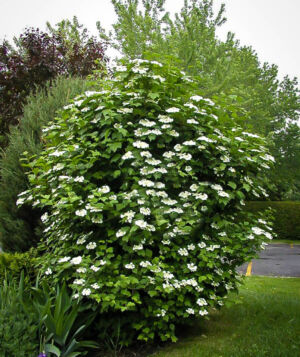Viburnum plicatum tomentosum- Doublefile Viburnum
Description
General: A large horizontal shaped flowering shrub with tiered branching. Is usually wider than it is tall and appears broad and rounded at maturity. Grows 8-10” in height with a 9-12” spread.
Leaves: Opposite, broad and ovate 2-4” long. Dark green with reddish purple fall color. Leaves tend to hang down on branches creating a “dog eared” effect.
Flowers: White flat topped cymes 2-4” in diameter that sit above the foliage. May. No fragrance but very showy.
Fruit: An egg shaped drupe 1/3” long changing from red to black and enjoyed by many bird species.
Attributes: One of the finest flowering deciduous shrubs for long lasting flowers, colorful fruits and fall color. Can be used as a specimen, for foundation plantings, in shrub borders or for massing.
Culture
Hardiness: Zones 5-7.
Growing Conditions: Demands moist, well drained soil and full sun to part shade.
Maintenance: No serious insect or disease issues. Does not require regular pruning but tolerates regenerative pruning to about 12” above ground if its become ratty or unhealthy looking.
Transplanting: Transplants easily.
Our Experience
We have several varieties of viburnum plicatum both on great hill and in our nursery stock. As we do tend to have drier soil, our viburnums can get tired looking during the heat of the summer when drought conditions exist. Supplemental water or shade may be required in these instances. Aside from drought related stress, we have no issues with this viburnum and find it greatly attributes to the landscape with three seasons of interest.
Viburnum carlessi- Koreanspice Viburnum
Description
General: A rounded, dense deciduous flowering shrub with stiff, upright spreading branches. Usually growing to 5’ but can grow to 8’ over time with similar width. Slow growing.
Leaves: Opposite, simple and broad-ovate 1-4” long. Dull dark green and hairy with a satiny sheen during the growing season changing to red, wine-red in the fall.
Flowers: Fragrant 2-3” flat topped cymes that are semi snowball shaped. Flowers are pink to red in bud and open white. Late April to early May.
Fruit: An egg shaped drupe 1/3” long and flattened, changing from red to black from August to September.
Attributes: A beautiful shrub to use for fragrance and color in the spring. Can be utilized as a foundation planting, as a specimen or in groupings.
Culture
Hardiness: Zones 5-7.
Growing Conditions: Best suited in well drained, slightly acidic soil. Full sun to part shade.
Maintenance: Bacterial leaf spot, powdery mildew and nematodes. Can be pruned for shape after flowering.
Transplanting: Transplants well balled and burlapped or container grown following cultural guidelines.
Our Experience
Experience at Great Hill
We utilize koreanspice viburnum in several screens and mixed borders throughout the landscape. They’re wonderfully fragrant throughout the spring and can be showy for fall color depending on cultivar. The majority of our specimens are mature and have surpassed 6’ in height and width. While we have not had an issue with leaf spot, mildew is noticeable some seasons.
Viburnum prunifolium- Blackhaw Viburnum
Description
General: A tree or multi-stemmed shrub, rounded at the top and stiffly branched. Typically grows 12 to 15’ in height with 8-12’ in width, but can reach 25’.
Leaves: Opposite, simple and broad-elliptic 1-3” long. Dark green color in the summer makes way for a variety of colors in the fall from purple, reddish purple to shining red or bronze.
Flowers: Creamy white 2-4” flat topped cymes in early April that emerge with the leaves.
Fruit: An oval drupe ½” long that starts out a rose color in September and matures to a bluish black throughout the fall. Fruits persist into winter and are attractive to birds and wildlife. They can also be used for preserves.
Attributes: Can be used as a small specimen tree, for massing or in shrub borders. Multi-seasonal use.
Culture
Hardiness: Zones 3-9.
Growing Conditions: Blackhaw is very adaptable to soil PH and does well in dry soils. Full sun to part shade.
Maintenance: No serious insect or disease issues.
Transplanting: Transplants well balled and burlapped or container grown following cultural guidelines.
Our Experience
Experience at Great Hill
We have a specimen blackhaw featured at the entrance to the landscape. We’re often asked which fruit tree it is as its habit is akin to crab or hawthorn. Beautiful when in flower, fruit and when displaying fall color.
Viburnum setigerum- Tea Viburnum
Description
General: An upright, rounded, multi-stemmed shrub growing 8 to 12’ tall.
Leaves: Opposite, simple and ovate 3 to 6” long. Blue green to dark green in the summer developing into a reddish purple in the fall.
Flowers: Small white flowers arranged in flat topped clusters 2” wide, April to May.
Fruit: An bright red egg shaped drupe ½” long in clusters from September to late in the fall. Tea viburnums produce the heaviest, most ornamental fruit set of the vibrnums, often causing their branches to arch downward from the weight.
Attributes: Useful in shrub borders, screens and hedges. As its habit is leggy, its best when used with other specimens.
Culture
Hardiness: Zones 5-7.
Growing Conditions: Prefers a well drained, moist loam but will tolerate a range of soils. Full sun to part shade.
Maintenance: No serious insect or disease issues. Doesn’t require pruning.
Transplanting: Transplants well if proper cultural requirements are met.
Our Experience
Experience at Great Hill
On great hill we utilize the ornamental properties of tea viburnum in several shrub borders. Their habit, leaf color, flower and berry set make this shrub ornamental throughout the growing season. Is called tea viburnum as its leaves were once used for making tea.
Viburnum sieboldii- Siebold Viburnum
Description
General: Large shrub or small tree with an open habit and stiff, rigid branching. Grows 15 to 20’ in height.
Leaves: Opposite and simple, 2 to 5” long. Dark green color in the summer, usually lacking fall color though an ashy purple is possible. Leaves are malodorous when crushed.
Flowers: Abundant creamy white panicle clusters 3 to 6” in May.
Fruit: An oval drupe up to ½” long. Rosy red color maturing to black from August through October.
Attributes: Used as a specimen, in groupings, against large buildings, as screens or hedges.
Culture
Hardiness: Zones 4-8.
Growing Conditions: Adaptable but prefers moist, well drained soils and full sun to part shade.
Maintenance: No serious issues with insects or diseases. Leaf scorch can develop if soils dry out.
Transplanting: Transplants easily.
Our Experience
Experience at Great Hill
The sieboldii featured on great hill are in a big grouping where they’ve grown quite leggy as they’re competing with some large trees for sunlight. Despite not being in as much sun as they’d prefer, they still flower profusely and display a heavy berry set in the fall. Their foliage is very clean and lustrous and even following flowering, their inflorescences linger a rosy red color providing aesthetic value throughout the fall.
Viburnum trilobum- American Cranberrybush
Description
General: A dense, rounded and hardy shrub growing 8 to 12′ in height with a similar spread
Leaves: Opposite, simple and three lobed, 2 to 5″ long. Dark green during the growing season making way for fall colors ranging from yellow to purple-reds
Flowers: White, 3 to 4″ flat topped cymes appear in May
Fruit: A rounded red drupe, 1/3″ long appears in September and persists through late winter of the following year
Attributes: An attractive native used for hedging, screening and massing- especially in moist areas.
Culture
Hardiness: Zones 2-7
Growing Conditions: Prefers well drained moist soils in full sun to part shade
Maintenance: Stem blight and borers
Transplanting: Transplants easily to moist sites
Our Experience
Experience at Great Hill
While we have not planted viburnum trilobum on the estate, its native to the area and can be found in the surrounding woods and nurseries in low, wet locations. Its multiseasonal interest make it a handsome addition to a wild, pollinator or native garden area.
2023
Viburnum Bloom Data 2023
| Plant Name | Bud Break | Full Bloom | Bloom Drop |
|---|---|---|---|
| plicatum tomentosum 'Mariesii' | No Bloom | ||
| plicatum tomentosum 'Summer Snowflake' | May 15 | May 24 | June 18 |
| prunifolium | May 12 | May 18 | May 27 |
| setigerum | May 12 | May 20 | May 26 |
| sieboldii | May 15 | May 20 | May 24 |
| carlesii 'Compactum' | April 27 | May 9 | May 17 |
| x carlcephalum | April 27 | May 8 | May 15 |
| x pragense | May 9 | May 15 | May 23 |
2022
Viburnum Bloom Data 2022
| Plant Name | Bud Break | Full Bloom | Bloom Drop |
|---|---|---|---|
| plicatum tomentosum 'Mariesii' | May 13 | May 25 | June 10 |
| plicatum tomentosum 'Summer Snowflake' | May 15 | May 23 | June 11 |
| prunifolium | May 12 | May 18 | May 27 |
| setigerum | May 10 | May 20 | June 1 |
| sieboldii | May 6 | May 18 | May 31 |
| carlesii 'Compactum' | May 7 | May 14 | May 21 |
| x carlcephalum | May 6 | May 16 | May 25 |
| x pragense | May 3 | May 19 | May 27 |

